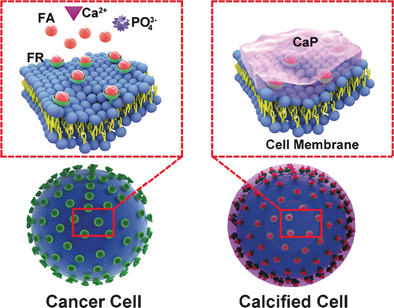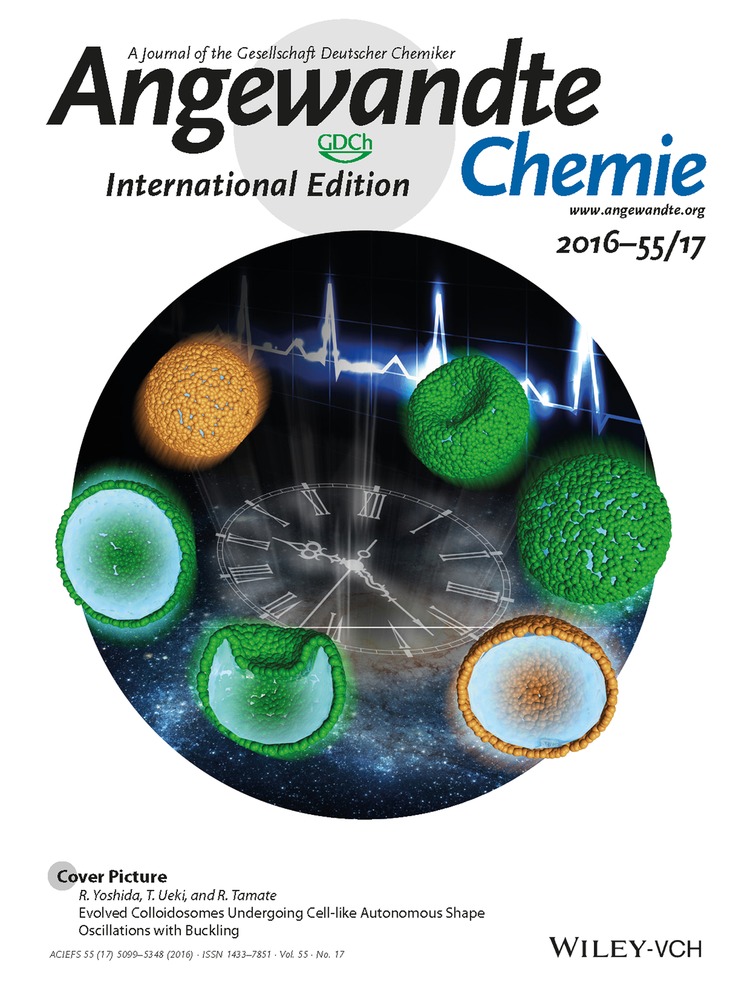A Drug-Free Tumor Therapy Strategy: Cancer-Cell-Targeting Calcification
Ruibo Zhao
Center for Biomaterials and Biopathways, Department of Chemistry, Zhejiang University, Hangzhou, Zhejiang, 310027 China
Search for more papers by this authorBen Wang
Cancer Institute, The Second Affiliated Hospital of Zhejiang University College of Medicine, Hangzhou, Zhejiang, 310009 China
Institute of Translational Medicine, Zhejiang University College of Medicine, Hangzhou, Zhejiang, 310029 China
Search for more papers by this authorXinyan Yang
Institute of Biological Engineering, Zhejiang Academy of Medical Sciences, Hangzhou, Zhejiang, 310013 China
Search for more papers by this authorYun Xiao
Cancer Institute, The Second Affiliated Hospital of Zhejiang University College of Medicine, Hangzhou, Zhejiang, 310009 China
Institute of Translational Medicine, Zhejiang University College of Medicine, Hangzhou, Zhejiang, 310029 China
Search for more papers by this authorXiaoyu Wang
Qiushi Academy for Advanced Studies, Zhejiang University, Hangzhou, Zhejiang, 310027 China
Search for more papers by this authorChangyu Shao
Center for Biomaterials and Biopathways, Department of Chemistry, Zhejiang University, Hangzhou, Zhejiang, 310027 China
Search for more papers by this authorCorresponding Author
Prof. Dr. Ruikang Tang
Center for Biomaterials and Biopathways, Department of Chemistry, Zhejiang University, Hangzhou, Zhejiang, 310027 China
Qiushi Academy for Advanced Studies, Zhejiang University, Hangzhou, Zhejiang, 310027 China
Search for more papers by this authorRuibo Zhao
Center for Biomaterials and Biopathways, Department of Chemistry, Zhejiang University, Hangzhou, Zhejiang, 310027 China
Search for more papers by this authorBen Wang
Cancer Institute, The Second Affiliated Hospital of Zhejiang University College of Medicine, Hangzhou, Zhejiang, 310009 China
Institute of Translational Medicine, Zhejiang University College of Medicine, Hangzhou, Zhejiang, 310029 China
Search for more papers by this authorXinyan Yang
Institute of Biological Engineering, Zhejiang Academy of Medical Sciences, Hangzhou, Zhejiang, 310013 China
Search for more papers by this authorYun Xiao
Cancer Institute, The Second Affiliated Hospital of Zhejiang University College of Medicine, Hangzhou, Zhejiang, 310009 China
Institute of Translational Medicine, Zhejiang University College of Medicine, Hangzhou, Zhejiang, 310029 China
Search for more papers by this authorXiaoyu Wang
Qiushi Academy for Advanced Studies, Zhejiang University, Hangzhou, Zhejiang, 310027 China
Search for more papers by this authorChangyu Shao
Center for Biomaterials and Biopathways, Department of Chemistry, Zhejiang University, Hangzhou, Zhejiang, 310027 China
Search for more papers by this authorCorresponding Author
Prof. Dr. Ruikang Tang
Center for Biomaterials and Biopathways, Department of Chemistry, Zhejiang University, Hangzhou, Zhejiang, 310027 China
Qiushi Academy for Advanced Studies, Zhejiang University, Hangzhou, Zhejiang, 310027 China
Search for more papers by this authorGraphical Abstract
Anticancer mineralization: Cancer-cell-targeting calcification can convert tumors into calcified tissues by using folic acid (FA), calcium, and the folate receptor (FR) resulting in cancer cell growth and metastatic inhibition without any drugs. These results suggest cancer cells can be selectively targeted using biomineralization methods.
Abstract
Herein, we propose a drug-free approach to cancer therapy that involves cancer cell targeting calcification (CCTC). Several types of cancer cells, such as HeLa cells, characterized by folate receptor (FR) overexpression, can selectively adsorb folate (FA) molecules and then concentrate Ca2+ locally to induce specific cell calcification. The resultant calcium mineral encapsulates the cancer cells, inducing their death, and in vivo assessments confirm that CCTC treatment can efficiently inhibit tumor growth and metastasis without damaging normal cells compared with conventional chemotherapy. Accordingly, CCTC remarkably improve the survival rate of tumor mice. Notably, both FA and calcium ions are essential ingredients in human metabolism, which means that CCTC is a successful drug-free method for tumor therapy. This achievement may further represent an alternative cancer therapy characterized by selective calcification-based substitution of sclerosis for tumor disease.
Supporting Information
As a service to our authors and readers, this journal provides supporting information supplied by the authors. Such materials are peer reviewed and may be re-organized for online delivery, but are not copy-edited or typeset. Technical support issues arising from supporting information (other than missing files) should be addressed to the authors.
| Filename | Description |
|---|---|
| anie201601364-sup-0001-misc_information.pdf7.1 MB | Supplementary |
Please note: The publisher is not responsible for the content or functionality of any supporting information supplied by the authors. Any queries (other than missing content) should be directed to the corresponding author for the article.
References
- 1
- 1aL. A. Torre, F. Bray, R. L. Siegel, J. Ferlay, J. Lortet-Tieulent, A. Jemal, CA Cancer J. Clin. 2015, 65, 87–108;
- 1bR. L. Siegel, K. D. Miller, A. Jemal, CA Cancer J. Clin. 2015, 65, 5–29.
- 2
- 2aT. A. Ahles, A. J. Saykin, Nat. Rev. Cancer 2007, 7, 192–201;
- 2bB. J. Noordman, J. J. B. van Lanschot, Nat. Rev. Clin. Oncol. 2015, 12, 425–431.
- 3
- 3aClinical Outcomes of Surgical Therapy Study, N. Engl. J. Med. 2004, 350, 2050–2059;
- 3bP. Naredi, M. P. La Quaglia, Nat. Rev. Clin. Oncol. 2015, 12, 425–431.
- 4
- 4aT. M. Allen, P. R. Cullis, Science 2004, 303, 1818–1822;
- 4bD. Peer, J. M. Karp, S. Hong, O. C. Farokhzad, R. Margalit, R. Langer, Nat. Nanotechnol. 2007, 2, 751–760;
- 4cA. Nel, T. Xia, L. Mädler, N. Li, Science 2006, 311, 622–627;
- 4dS. Sharifi, S. Behzadi, S. Laurent, M. L. Forrest, P. Stroeve, M. Mahmoudi, Chem. Soc. Rev. 2012, 41, 2323–2343.
- 5S. V. Dorozhkin, M. Epple, Angew. Chem. Int. Ed. 2002, 41, 3130–3146;
10.1002/1521-3773(20020902)41:17<3130::AID-ANIE3130>3.0.CO;2-1 CAS PubMed Web of Science® Google ScholarAngew. Chem. 2002, 114, 3260–3277.
- 6
- 6aL. L. Demer, Y. Tintut, Circulation 2008, 117, 2938–2948;
- 6bA. P. Sage, Y. Tintut, L. L. Demer, Nat. Rev. Cardiol. 2010, 7, 528–536.
- 7
- 7aB. Wang, P. Liu, W. Jiang, H. Pan, X. Xu, R. Tang, Angew. Chem. Int. Ed. 2008, 47, 3560–3564; Angew. Chem. 2008, 120, 3616–3620;
- 7bY. Wei, G. Yin, C. Ma, X. Liao, X. Chen, Z. Huang, Y. Yao, Med. Hypotheses 2013, 81, 169–171;
- 7cW. Chen, G. C. Wang, R. K. Tang, Nano Res. 2014, 7, 1404–1428.
- 8
- 8aJ. H. Park, K. Kim, J. Lee, J. Y. Choi, D. Hong, S. H. Yang, F. Caruso, Y. Lee, I. S. Choi, Angew. Chem. Int. Ed. 2014, 53, 12420–12425; Angew. Chem. 2014, 126, 12628–12633;
- 8bB. J. Kim, T. Park, H. C. Moon, S. Y. Park, D. Hong, E. H. Ko, J. Y. Kim, J. W. Hong, S. W. Han, Y. G. Kim, I. S. Choi, Angew. Chem. Int. Ed. 2014, 53, 14443–14446; Angew. Chem. 2014, 126, 14671–14674;
- 8cW. Li, W. Bing, S. Huang, J. Ren, X. Qu, Adv. Funct. Mater. 2015, 25, 3775–3784;
- 8dS. H. Yang, J. Choi, L. Palanikumar, E. S. Choi, J. Lee, J. Kim, I. S. Choi, J. H. Ryu, Chem. Sci. 2015, 6, 4698–4703;
- 8eS. H. Yang, E. H. Ko, Y. H. Jung, I. S. Choi, Angew. Chem. Int. Ed. 2011, 50, 6115–6118; Angew. Chem. 2011, 123, 6239–6242;
- 8fW. Xiong, X. Zhao, G. Zhu, C. Shao, Y. Li, W. Ma, X. Xu, R. Tang, Angew. Chem. Int. Ed. 2015, 54, 11961–11965; Angew. Chem. 2015, 127, 12129–12133.
- 9J. Lee, J. Choi, J. H. Park, M. H. Kim, D. Hong, H. Cho, S. H. Yang, I. S. Choi, Angew. Chem. Int. Ed. 2014, 53, 8056–8059; Angew. Chem. 2014, 126, 8194–8197.
- 10
- 10aP. S. Low, W. A. Henne, D. D. Doorneweerd, Acc. Chem. Res. 2008, 41, 120–129;
- 10bW. He, H. Wang, L. C. Hartmann, J. X. Cheng, P. S. Low, Proc. Natl. Acad. Sci. USA 2007, 104, 11760–11765;
- 10cB. Wang, P. Liu, Z. Liu, H. Pan, X. Xu, R. Tang, Biotechnol. Bioeng. 2014, 111, 386–395.
- 11
- 11aA. Fleming, A. J. Copp, Science 1998, 280, 2107–2109;
- 11bR. Schneggenburger, E. Neher, Nature 2000, 406, 889–893.
- 12Y. Tu, M. Lv, P. Xiu, T. Huynh, M. Zhang, M. Castelli, Z. Liu, Q. Huang, C. Fan, H. Fang, Nat. Nanotechnol. 2013, 8, 594–601.
- 13R. S. Jansen, A. Küçükosmanoğlu, T. G. M. F. Gorgels, P. Borst, Proc. Natl. Acad. Sci. USA 2013, 110, 20206–20211.
- 14
- 14aD. W. Holdsworth, M. M. Thornton, Trends Biotechnol. 2002, 20, S 34–S39;
- 14bA. Ale, V. Ermolayev, M. H. de Angelis, V. Ntziachristos, Nat. Methods 2012, 9, 615–620.
- 15E. Woldt, J. Terrand, M. Mlih, S. Foppolo, Z. El Asmar, M. E. Chollet, E. Ninio, Nat. Commun. 2012, 3, 1077–1086.
- 16P. Amarengo, C. Duyckaerts, C. Tzourio, D. Hénin, M. G. Bousser, J. J. Hauw, N. Engl. J. Med. 1992, 326, 221–225.
- 17D. S. Kohane, R. Langer, Chem. Sci. 2010, 1, 441–446.
- 18R. R. Arvizo, S. Saha, E. Wang, J. D. Robertson, R. Bhattacharya, P. Mukherjee, Proc. Natl. Acad. Sci. USA 2013, 110, 6700–6705.
- 19C. L. Chaffer, R. A. Weinberg, Science 2011, 331, 1559–1564.





